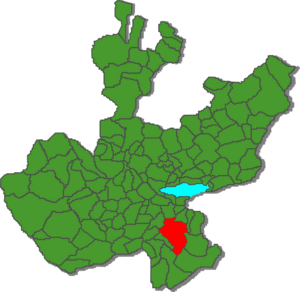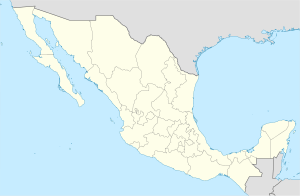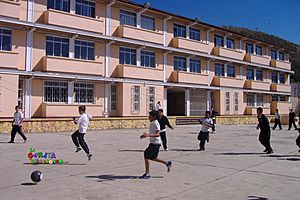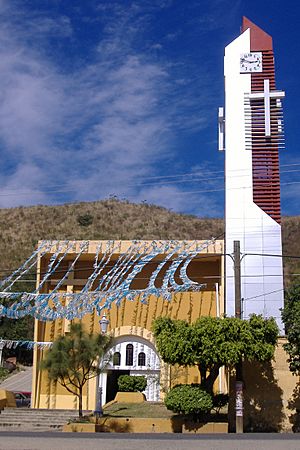La Garita, Jalisco facts for kids
Quick facts for kids
La Garita
La Garita de San Lázaro
|
||
|---|---|---|
|
Delegacion and Town
|
||

Downtown Plaza
|
||
|
||
| Etymology: San Lázaro | ||
| Motto(s):
~*~Pueblo Alegre~*~ Joyful Town
|
||

Location of the municipality in Jalisco
|
||
| Country | ||
| State | Jalisco | |
| Municipalities of Jalisco | Tamazula de Gordiano | |
| Elevation | 1,229 m (4,032.152 ft) | |
| Population
(2010)
|
||
| • Total | 1,060 | |
| Time zone | UTC-6 (Central Standard Time) | |
| • Summer (DST) | UTC-5 (Central Daylight Time) | |
| Postal Code |
49667
|
|
| Area code(s) | 358 | |
| Website | LaGaritaJalisco.com | |
La Garita is a town in the Mexican state of Jalisco. It is part of the Tamazula de Gordiano area. In 2010, about 1,060 people lived there. However, many people from La Garita have moved to other places. About 1,000 people now live in the United States. Most of them are in states like California and Illinois. Some have also moved to nearby Mexican cities like Tamazula de Gordiano and Guadalajara.
Contents
History of La Garita
La Garita started as a large property called the Hacienda of San Lázaro. Rich business people settled it around 1846. San Lázaro, or Saint Lazarus, was the special protector of the area.
Why is it Called La Garita?
Long ago, merchants traveled from Michoacán to Colima. They used animals to carry their goods. This journey was very long and hard. They would stop in this area to rest and trade. This place became a safe spot for them. That is why it was called "La Garita." The word "garita" comes from an old French word meaning "refuge" or "shelter."
People from many places, including other countries, came to live here. They built properties. The landowners controlled the land and the region.
Changes to the Land
Later, under President Lázaro Cárdenas, the government changed the land system. The land became "ejidal," which means it was communal land. This land was given to farmers to use for growing crops and building homes.
In 1940, a new state highway, Jiquilpan-Manzanillo 110, was built. This road goes right through La Garita. It connected the town to places like Mazamitla and Tamazula de Gordiano. This highway helped the town connect with the outside world.
The town's name also changed. It went from "Hacienda de San Lázaro" to "La Garita de San Lázaro." Over time, people just called it "La Garita." In 1946, La Garita became a "Delegación." This meant it had its own civil registry and a police group.
Population Facts
Here are some facts about the people living in La Garita from the 2010 census:
| Town | Total Population | Number of Men | Number of Women | Occupied Dwellings |
|---|---|---|---|---|
| La Garita | 1,060 | 483 | 577 | 285 |
Geography of La Garita
La Garita is located next to the Tamazula River. This river forms in La Garita where two smaller rivers meet. The town's elevation changes a lot because of the hills and mountains around the river.
Town Layout and Neighborhoods
About half of La Garita is in a valley created by the river. The other half is on the hills. These hills are part of the Sierra Madre Occidental and the Sierra del Tigre mountain ranges. These areas are known for their forests.
The town is split into two main parts by Highway 110:
- Upper Neighborhood: This part is on a hill.
- Lower Neighborhood: This part is in the valley by the river.
In the middle of town, there is a plaza. It was built with time and money donated by the town's people. This plaza is a central spot for gatherings and celebrations. Around the plaza, a new "central neighborhood" grew. Most restaurants and shops are found here.
The town also has smaller areas called "barrios." These were created by the church. Each barrio helps host a special symbol during the town's "feria" (fair). The barrios are named after Catholic saints or religious symbols:
- Barrio de San Judas Tadeo
- Barrio de la Virgen de Guadalupe
- Barrio de Santa Maria Goretti
- Barrio del Sagrado Corazón de Jesús
- Barrio de Juan Pablo II
- Barrio de San Rodrigo Aguilar
- Barrio de la Sagrada Familia
- Barrio de San Antonio
- Barrio de la Virgen del Sagrario
- Barrio de San Jose
Climate in La Garita
La Garita usually has warm weather all year. The wet, rainy season starts in summer. This means it rains more often than it is sunny. The people and the land are used to a dry year followed by a very wet early summer.
The rains are good for the sugarcane crops. Sugarcane is a major crop in this area. Most of the rain comes from the Pacific Ocean, often from tropical storms or even hurricanes.
During the rest of the year, it is sunny, warm, and pleasant. This tropical climate lasts through late summer and autumn. Winter and spring are the dry season, with very little rain.
Transportation in La Garita
Getting around La Garita has sometimes been a challenge. There isn't one main place for all travel. However, the national highway 110 goes through the town. This means buses traveling between major cities often stop in La Garita.
In the town center, there is an area by the highway where taxis and buses stop. National buses also stop here, usually at the northeastern end of town. There is no train station. Most visitors travel by car, bus, or taxi from nearby cities like Tamazula and Mazamitla. These cities have main bus stations.
The nearby city of Tamazula de Gordiano built a new main bus station in 2012. This station serves local, regional, and national buses.
Airports Near La Garita
The closest airports are:
- Miguel Hidalgo International Airport (GDL): This airport is in Guadalajara, Jalisco, about three hours away. It offers daily international flights to many cities where La Garita residents have family.
- Colima National Airport: This airport is in the city of Colima, about two and a half hours away.
Both airports offer bus service to Tamazula and Mazamitla. These buses might stop in La Garita if needed.
Economy of La Garita
La Garita has a diverse economy, much like other tourist areas in Mexico. Most of the money earned by its people comes from farming. The town is one of the biggest sugarcane producers in the area.
Sugarcane and Farming
Different types of sugarcane are grown and harvested. This sugarcane is taken to "Ingenio Tamazula, S.A. de C.V." in Tamazula de Gordiano. There, it is turned into sugar. The sugar-making process also creates molasses and pure cane alcohol, which are sold locally.
Even though sugarcane is the main source of income, La Garita also has many other businesses. These include shops, restaurants, pharmacies, and even a waterpark.
Farmers also use their land for growing corn, alfalfa, and pasture. Some people raise animals like cows, pigs, chickens, goats, and sheep. While not as popular as farming, raising livestock is another way to earn a living.
Tourism and Support
Many people in La Garita earn money from tourism. Visitors come during religious festivals, to see the nearby "El Carrizo" river dam, and to enjoy the "Las Jaras" waterpark with its natural thermal waters.
Some residents also receive money from family members who live in the United States. Many of these family members live in the Chicago area and southern California.
What to See and Do
The national highway Mexico 110 divides the town. This highway runs from Jiquilpan to the port of Manzanillo. The area along the highway, from Tamazula de Gordiano to Mazamitla, is known as the "Sierra del Tigre" tourist region. This area focuses on eco-tourism, which means enjoying nature.
La Garita is right in the middle of this tourist corridor. It is also where the road to the new "El Carrizo" river dam begins. This dam has become a fun place for diving, boating, and fishing.
Famous Foods of La Garita
La Garita is known for its delicious Mexican food:
- Birria de Chivo: A tasty stew made with marinated goat meat.
- Sopitos: Small corn tortillas, fried, with minced meat, sauce, and cabbage. They are similar to tacos.
- Tostadas de Lomo: Large fried tortillas topped with mayonnaise or refried beans, fried pork loin, cabbage, tomatoes, onions, cheese, and sauce.
- Tacos de Cabeza: Tacos made with beef from the cow's head, cilantro, onions, and spicy tomatillo sauce.
- Tacos de Adobada: Tacos made with marinated pork tenderloin, cilantro, onions, and spicy tomatillo sauce.
- Enchiladas: Corn tortillas rolled up and filled, then topped with a spicy or sweet sauce, cabbage, and grated cheese.
- Tortas de Lomo: A sandwich made with a crispy roll, fried pork loin, lettuce, tomatoes, onions, cheese, mayonnaise, and sometimes jalapeño peppers.
- Tamales: Corn cakes filled with pork or beef in red or green hot sauce, cheese, or sliced peppers.
- Carnitas: Fried pork prepared in many ways, including different parts of the pig.
For drinks, you can find:
- Freshly squeezed juices every morning (like carrot, beet, orange, apple, celery).
- Chocolate milk with "rompope" (a type of eggnog), quail eggs, protein powder, and cinnamon.
- Atole: A warm drink made with flour, brown sugar, milk, vanilla, and cinnamon.
Important Landmarks
- La Parroquia de La Garita: This church is a town landmark. It is known for its modern Clock Tower and is considered one of the most unique churches in Jalisco.
- The Formal Hacienda of San Lázaro: This is the current home of the Gutierrez family. It is a landmark and one of the few remaining parts of the original Hacienda that founded the town.
Education in La Garita
La Garita has three public schools for children from kindergarten to ninth grade. All three schools are in the upper part of town. They were built there to be safe from floods that used to happen in the lower part of town.
- Kindergarten: A small school called Jardin de Niños is available for children starting at age 5.
- Elementary School: The older elementary school, Revolución, was recently replaced. A new three-story building with modern features and computer labs was built. Elementary school in Mexico goes from first to sixth grade.
- Junior High: A junior high school is also in town, though a bit farther from the center. It serves students from seventh to ninth grade. In Mexico, this is called secundaria, or secondary education.
Religion in La Garita
Religion is a very important part of life and culture in La Garita. There is one main church in town, La Parroquia de La Garita. The town celebrates many saints and the Virgin of Guadalupe, like most of Mexico.
However, each town also has a special celebration or fair called "la feria" for its own patron saint. La Garita's patron saint is San Lázaro. The celebration for San Lázaro has recently been brought back. Another very popular celebration is for the Virgin of the Tabernacle, or "Virgen del Sagrario."
These fairs last for several days. They include different activities to honor the saint or virgin, plus entertainment. Many tourists and visitors come to town for these events. There are concerts with popular bands, mariachi music, and pop stars.
- The celebration for the "Virgen del Sagrario" is from November 20 to November 30 each year.
- The celebration for the town's patron, "San Lázaro," is from December 17 to December 22 each year.
About 89% of the people in La Garita are Catholic. The other 11% either do not have a specific religion or are other Christians. The number of Christians is growing, with about 5% being Baptist, Pentecostal, or Jehovah's Witness.
Sports in La Garita
Soccer is the most popular sport in La Garita. The town has a team called La Garita in the Municipal League. This team is becoming a strong competitor, with teams for younger players (Juveniles) and intermediate players (Intermedias).
Rodeo and bull riding are also popular, especially during religious festivals like the Feria de la Virgen de Sagrario.
Basketball has also become popular. There is a basketball court in a new community park. This park also has a new soccer field with stands for spectators, a concert stage, and more, right by the river.
See also
 In Spanish: La Garita (Jalisco) para niños
In Spanish: La Garita (Jalisco) para niños





